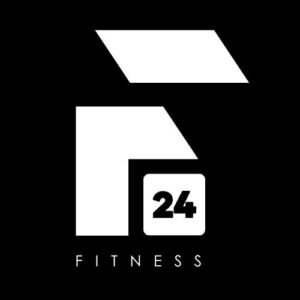Introduction: Why Balance Matters in Fitness
Start with a big-picture thought: your diet fuels every workout and recovery moment. Eating a variety of foods in the right amounts helps you maintain energy, build muscle, burn fat, and feel strong. Too much or too little of any nutrient can leave you sluggish, weak, or stalled in your progress. So balance isn’t only about health—it’s about getting the most from every rep, run, or session.
When we say “balanced diet for fitness,” we mean a plan that includes all three main macronutrients—carbs, proteins, fats—plus vitamins, minerals, fiber, and enough water. These nutrients play specific roles: carbs give energy, protein builds and repairs muscle, and fats support hormones and joint health. Trim out whole food groups, and you risk nutrient deficiencies, low energy, or failing results. On the other hand, too much of anything can mess with body composition or cause weight gain.
So how do you put that balance into real meals? Let’s walk through the building blocks.
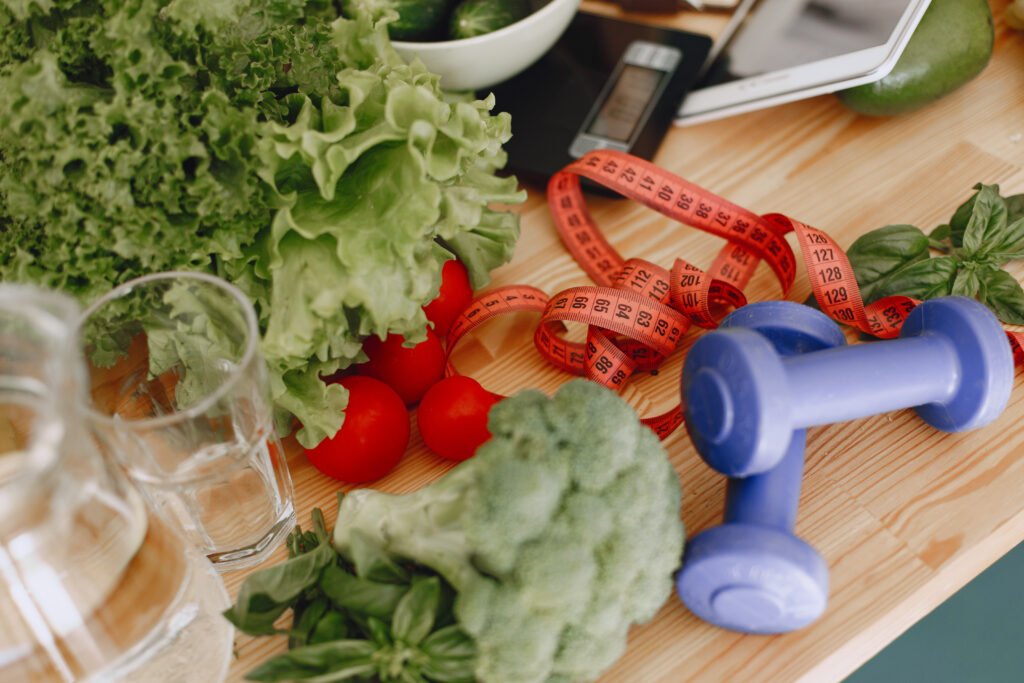
Step 1: Calculate Your Daily Calories
The first step is knowing how many calories you need to maintain, gain, or lose weight.
Health experts like the American Heart Association suggest finding your maintenance calories by figuring out your Resting Metabolic Rate (RMR), then adding activity levels . Plenty of online calculators can do this for you—you’ll input age, height, weight, activity level, and goal (e.g., maintain, gain muscle, lose fat). This gives you your Total Daily Energy Expenditure (TDEE).
Once you have that:
- To gain muscle, eat a small surplus, like 10–15% more than your maintenance.
- To lose fat, create a moderate deficit, around 10–20% less.
- If your goal is balanced fitness and maintenance, stick close to that maintenance calorie level.
Tracking calories isn’t about focusing on numbers forever; it’s a tool to get oriented. After a few weeks, you’ll notice how your body responds and can adjust naturally.
🍚 Step 2: Set Your Macronutrient Ratios
Once calories are set, divide them among protein, carbs, and fats.
Standard Ranges
- Carbohydrates: 45–65% of total calories
- Protein: 10–35%
- Fat: 20–35% Health+2ACE Fitness+2Medical News Today+2
That range gives flexibility. But to simplify, smaller ranges often work well:
- Active fitness: Carbs 45–55%, Protein 25–30%, Fat 20–30%
- Muscle gain: Carbs 45–60%, Protein 25–35%, Fat 15–25%
- Fat loss: Carbs 40–50%, Protein 30–35%, Fat 20–30%
A popular approach is the 40/30/30 split (40% carbs, 30% protein, 30% fats). It’s simple to remember and well-suited for balanced fitness goals myvitalmetrics.com+7Lean-Lifestyle+7Health+7.
Let’s turn percentages into grams:
- Multiply your calorie target by the macro percentage.
- Divide calories by macro calorie-per-gram:
- Carbs 4 kcal/g
- Protein 4 kcal/g
- Fat 9 kcal/g
Example: On a 2,400‑calorie diet with a 40/30/30 split:
- 960 kcal from carbs → 240 g
- 720 kcal from protein → 180 g
- 720 kcal from fat → 80 g
These numbers guide your food intake daily.
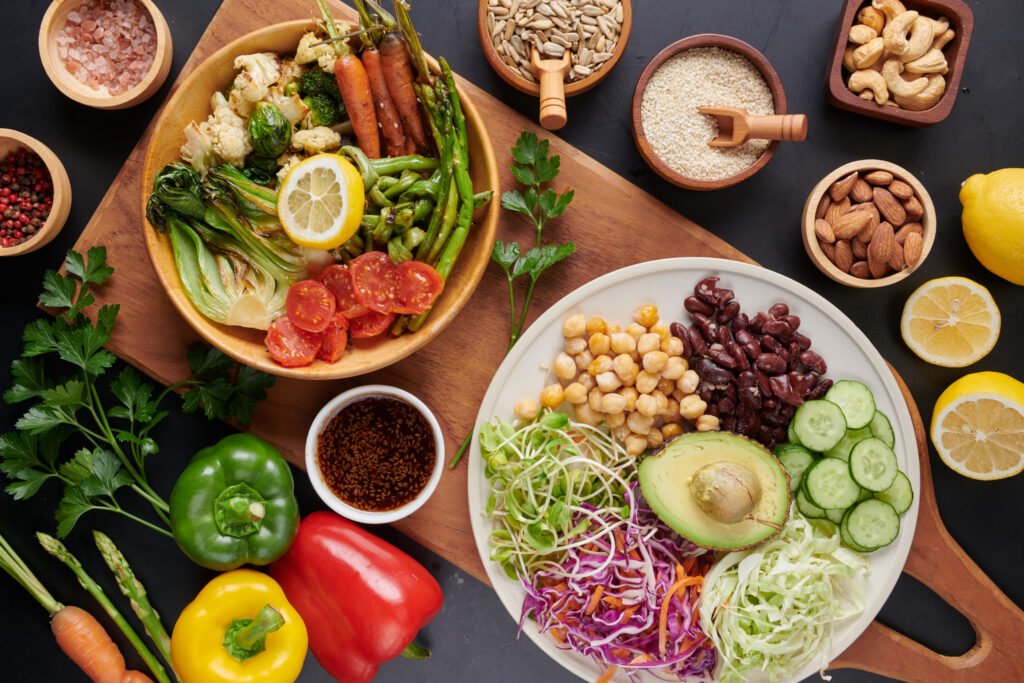
🥘 Step 3: Choose Quality Foods
Once you know your targets, focus on nutrient-dense foods.
Carbohydrates:
Prioritize whole grains, fruits, vegetables, legumes, and starchy vegetables like potatoes and squash Rudi’sGQVerywell HealthGQ+4ACE Fitness+4Verywell Health+4. These release energy steadily, provide fiber, vitamins, and minerals, and support sustained energy for workouts.
Quick sources around workouts include oats, bananas, rice, and whole-grain bread. Make simple switches: swap white rice for brown, soda for sparkling water with fruit, or candy for apples and almonds.
Proteins:
Aim for lean, complete protein sources: chicken, turkey, fish, eggs, low-fat dairy, beans, lentils, tofu, and Greek yogurt . Protein supports muscle repair and growth, and eating it throughout the day helps maintain muscle mass.
Most fitness plans aim for 1.6–2.5 g/kg body weight per day, depending on goal Glamour+13SELF+13myvitalmetrics.com+13ACE Fitness. Spread it evenly across meals—roughly 20–40 grams per meal.
Fats:
Focus on healthy unsaturated fats: olive and canola oil, nuts, seeds, avocados, and fatty fish like salmon and mackerel . Fats support hormones, heart health, and satiety. Keep saturated fat low, avoid trans fats, and keep these between 20–35% of your calories .
🕒 Step 4: Plan Your Meals & Timing
Good pre-workout options:
- Oatmeal with fruit
- Banana with nut butter
- Greek yogurt with berries
During workouts (only longer than 60 minutes or intense sessions):
Grab simple carbs like sports drinks, gels, or fruit to sustain energy CDC+3Mayo Clinic+3Mayo Clinic Health System+3.
After workouts:
Refuel within 30 minutes to 2 hours. Aim for carbs + protein to replenish glycogen and support muscle repair .
Examples:
- Protein smoothie with banana
- Turkey sandwich on whole-grain bread
- Greek yogurt with fruit and granola
Across the day:
Eat 3–5 meals or snacks, spreading protein evenly. Keep each meal balanced: half plate with veggies/fruit, a quarter with whole grains/carbs, and a quarter with protein, plus a source of healthy fat Rudi’s+15nutritionsource.hsph.harvard.edu+15nhlbi.nih.gov+15nhlbi.nih.gov+3Mayo Clinic+3Healthline+3Health+1www.heart.org+1.
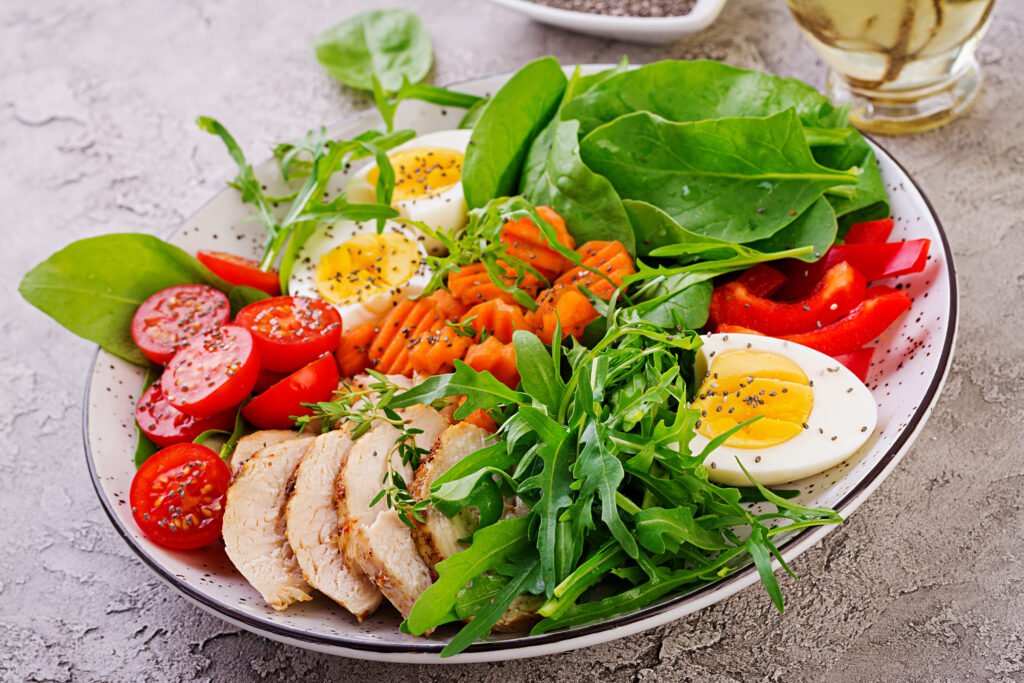
💧 Step 5: Hydration & Micronutrients
Hydration is critical—even losing 2% body water can reduce performance by ~5% . A good rule: drink half your body weight in ounces of fluid daily. Adjust based on sweat, temperature, and activity.
Water is best. Plain coffee or tea is fine. Sports drinks help replenish electrolytes during intense workouts but aren’t needed daily. Also include fruit and vegetables—they hydrate and supply vitamins, minerals, and antioxidants.
Focus on a variety of fruits and veggies—at least 5 servings everyday Mayo Clinic Health System. Rotate greens, reds, oranges, purples, and dark leafy varieties. Throw in nuts, seeds, dairy or fortified plant milk, lean protein, and whole grains to cover calcium, vitamin D, potassium, magnesium, and dietary fiber.
🛠 Step 6: Adjust & Track Progress
Monitoring how you feel, perform, and look is key.
- Energy & workouts: Are you energized during workouts? Recovering well? If fatigue hits, you may need more carbs or sleep.
- Muscle & strength: Track strength gains—if stalled, increase protein or calories.
- Body composition: If fat loss stalls, reduce calories slightly or boost activity. If losing muscle, eat more protein and strength-train.
- Digestive health & mood: Fibre, hydration, mindful eating = better digestion. Don’t ignore stress, sleep, or rest days—they influence recovery and appetite.
Weigh weekly or biweekly, and consider progress photos, how clothes fit, or energy levels. Adjust calories in 5–10% increments only. Retool macros after 4–6 weeks to fit new goals.
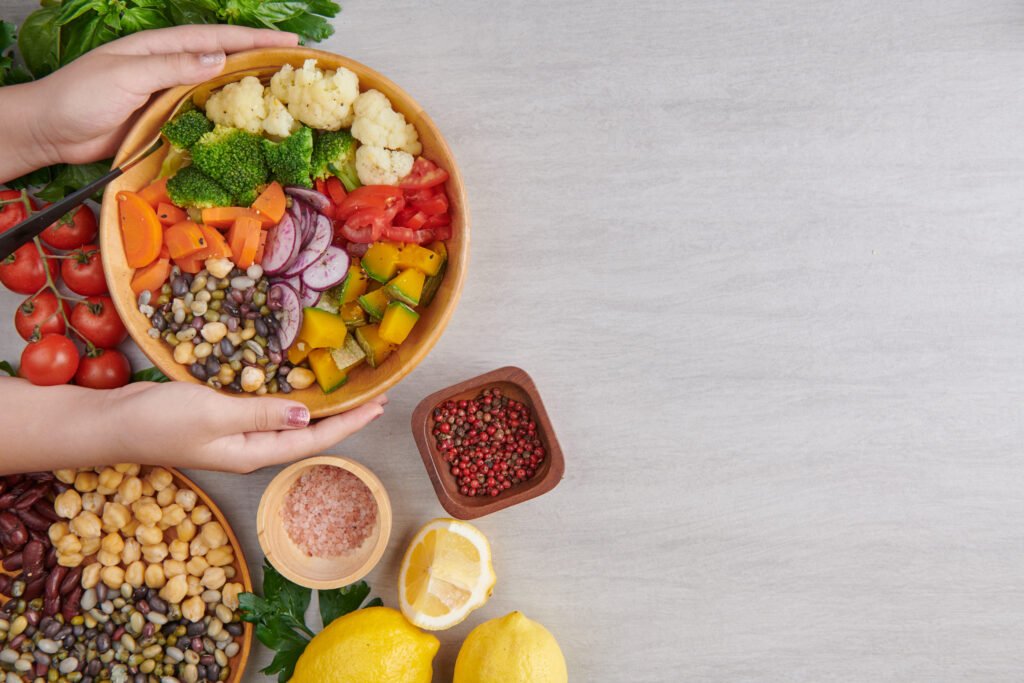
📋 Sample Daily Plan (2,400 kcal @ 40/30/30)
Breakfast
- 1 cup oatmeal with berries and honey
- 3 eggs
- Black coffee
Macros: ~60 g carbs / 25 g protein / 15 g fat
Mid-Morning Snack
- Greek yogurt + banana + almond butter
Macros: ~40 g / 20 g / 15 g
Lunch
- Grilled chicken breast
- Brown rice
- Mixed salad with olive oil dressing
- Apple
Macros: ~70 g / 40 g / 20 g
Pre-Workout
- Whole-grain toast + turkey slices + avocado
Macros: ~30 g / 20 g / 15 g
Post-Workout
- Protein shake + banana
Macros: ~40 g / 30 g / 5 g
Dinner
- Baked salmon
- Sweet potato
- Steamed broccoli with olive oil
Macros: ~60 g / 40 g / 25 g
Evening Snack (optional)
- Cottage cheese + berries or nuts
Macros: ~20 g / 15 g / 10 g
This plan covers ~320 g carbs / 190 g protein / 105 g fat—balanced around the 40/30/30 ratio with flexibility.
⚠️ Common Challenges & Tips
- Counting macros feels tedious: You don’t have to track forever. Do it for 1–2 weeks to learn portion sizes, then eat mindfully.
- Quality vs. quantity: Prioritize whole foods over processed ones, even if macros match GlamourLean-Lifestyle.
- Flexibility matters: You don’t have to be strict every day. Fit in treats occasionally—just make sure most meals support your goals.
- Meal prep helps: Cook large batches of healthy staples—grilled protein, veggies, grains—so you always have nutritious options.
- Adjust based on progress: If results stall, tweak calories or macros slightly. No wild swings.
🧠 Mindset & Sustainability
A fitness diet should feel sustainable and enjoyable. Too much rigidity can lead to burnout or unhealthy habits. Allow yourself to listen to hunger cues, eat with intention, and enjoy meals. Flexibility leads to long-term success.
Avoid diet extremes like keto, juice cleanses, or skipping macros completely unless guided by a healthcare provider—they can cause nutrient imbalances or energy issues over time.
Focus on progress, not perfection. A consistent, balanced approach beats peaks and troughs any day.
🧩 Bottom Line
- Calculate daily calorie needs (TDEE).
- Choose a macro split (e.g., 40/30/30).
- Select nutrient-dense foods across macros.
- Eat throughout the day, timing around workouts.
- Hydrate and cover micronutrients.
- Track progress and adjust slowly.
- Build a diet you can stick with—balance, not perfection.
When food supports your fitness, performance improves, energy rises, and results follow. The steps here guide you to a diet that’s simple, balanced, and tailored to your goals.
